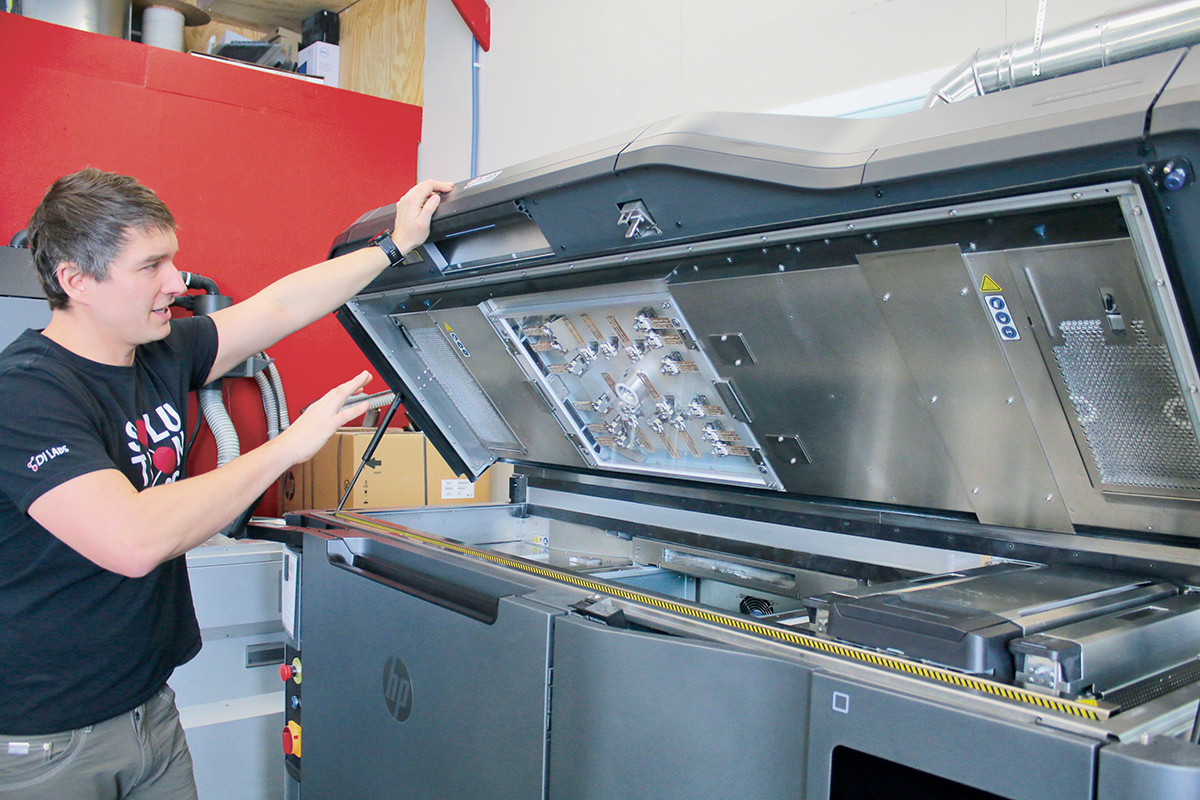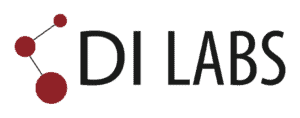
February 1, 2020: By Brett Blocker, Editor, Lakes Area Review – Two-thousand miles removed from the tech hubs of Silicon Valley and an ocean away from the burgeoning markets of Beijing, the small town of Spicer is about the last place one would expect to find the frontline of fabrication.
But tucked behind rows of oak trees at the end of a winding wooded driveway, in an otherwise unassuming building along 113th Ave NE, a trio of engineering brothers are, quite literally, developing the “cutting edge” of 3D printing as the manufacturing industry knows it.
It is there, in the Douglass brothers’ single-story, 3,200-square-foot “DI Labs” facility, that the team is assisting in developing the world’s first “DyeMansion Powerfuse S” finisher – a German engineered machine that will allow DI Labs to 3D print medical devices that, until now, required a level of surface quality not capable by print fabrication alone.
DI Labs received the finisher from the DyeMansion company several weeks ago after previously meeting with their leadership team in December. Following the meeting at the Spicer site, DI Labs agreed to purchase the machine and collaborate with DyeMansion to troubleshoot any developmental “bugs” as they arise.

DI Labs President Carl Douglass pictured with the world’s first “DyeMansion Powerfuse S” finisher, which will allow the Spicer 3D printing company to create devices for the medical industry. (photo by Brett Blocker)
According to DI Labs co-founder Carl Douglass, the finisher is expected to be up and running within the month.
Since initially founding the company as Douglass Innovations in 2013 – and rebranding itself as DI Labs in 2017 – the business works as an engineering consulting firm, helping clients develop specific parts which can then be manufactured from one of the lab’s 12 3D printers.
With clients across the country and in all varieties of industry, the lab prints about 25,000 parts per month including everything from engine manifolds for luxury vehicles to airplane fuselages and frames for drone aircraft.
“We don’t really focus on one particular industry,” Carl explained. “Typically how it works is a customer will come to us in one of these industries and say ‘hey, look,’ I’ve got this problem and I don’t know how to solve it. Can you help me?’ And a lot of those problems we’re solving for the very first time […] so we develop our own process.”
For a time, nothing seemed out of the realm of possibility for DI Labs, be it a 10’ by 5’ aircraft body, or pinky-sized gears – that is, until the lab began receiving requests from medical device manufacturers in Minneapolis that pushed the limits of existing technology.
“They had specific requirements for us to print parts that would be used in finished applications, and we weren’t able to meet those requirements without having an advanced technology,” Carl said. “Initially, we started developing a technology in-house, something similar to [the DyeMansion Powerfuse S”] but we ended up getting connected with the company before it was even released. […] We were able to purchase the machine and co-develop the process as it moves forward.”
It’s not the first time DI Labs has experimented with new technology. In 2017, the business was the first in the state to use a “multi-jet fusion printer” for parts fabrication.

Carl Douglass cracks the hood of DI Labs’ “multi-jet fusion printer,” used for parts fabrication. The company was the first in the state to use the printer when it received the machine in 2017. (photo by Brett Blocker)
Over the last 51 days alone, the business has added seven new pieces of equipment, effectively packing the work floor to capacity.
While these new printers increased the workload the lab was able to take on, the finisher will open the lab to an entirely new market.
“The equipment that we invested in over the last several months is all about putting us in a position to do low-volume production for consumer devices, food-safe products and medical devices,” Carl said, “because the tech that previously existed wouldn’t allow that.”
How the finisher works
To understand how the finisher may revolutionize the 3D printing industry, one must first understand how the printing process operates.
First, a digital schematic for a part is drafted. That blueprint is then sent to a 3D printing machine, which houses a cart of powdered nylon plastic. The machine heats this powder to its near-melting point and, layer by layer, constructs the part using a fusing agent in the shape of the part according to the provided schematic.
After the printer completes the fusion, the part is left to cool before it is sandblasted and vacuumed to remove excess powder. The part is then inspected and prepared for shipping.
However, this process leaves parts with microscopic bumps and ridges that, while inconsequential in the production of gears and auto parts, would render medical devices unusable as they provide spaces for pathogens to settle.
This is where the finisher comes in.
Once the finisher is up and running, sandblasted parts will be placed on a cart and fed into the machine, where they will be sprayed with a plastic-melting chemical vapor that will smooth microscopic ridges by an additional 85%.
By smoothing the surface texture from 10 microns to just 1.5, these parts, Carl said, will be able to meet the requirements for use in operating rooms.
Previous attempts at fabrication technology, he said, were unsuccessful – in large part – to an inability to find a balance between a chemical that would be powerful enough to melt plastic, but mild enough to be used around people.
One such chemical that is used in other applications, he added, would cause a heart attack in a human exposed to a single drop.
This fabricator, he said, will use a chemical similar to a household cleaner. “The parts that will come out of it are food safe. So we could fuse a plastic spoon and eat off of it when we’re done.”
The future of fabrication
While traditional molding has been used to create medical devices for decades, this process can be costly, and requires a specific mold for each part. Moreover, creating each parts mold takes time. Through 3D printing, these limiting factors can be mitigated.
“Molding is really good; you can create parts that are really, really smooth,” Carl said. “The problem is that it can cost hundreds of thousands of dollars, if not millions, to make molded parts. And on top of that, it takes months and months and months to make the tooling (individual mold) for each part. In our case, there’s no tooling, no millions of dollars spent on that, nor the time wasted for those parts to be created. You could send us a digital file tomorrow and by Wednesday we could send you produced parts.”
There is a cost to 3D printing, however.
Print fabrication does not require the up-front costs of molding, but each part is generally more expensive to create.
“If you’re running millions of parts, then 3D printing probably isn’t the best application. But if you’re running 10,000 parts, or 10,000 parts where each one needs to be different, then it’s really great. Molding could never do that.”
Along with foregoing costly single-purpose molds, 3D printing can also slash product development time by months. “The lead time on any product in development is always critical, and is extremely critical with medical devices because of the regulatory side of it which takes a significant amount of time. So as a medical device technology firm, if I can speed up my iterations before I get to the regulatory bodies, then that completely changes the game.”
To maximize efficiency at the lab and further reduce lead times, Carl and his team have at least one printer running at all times. The others come online at night so that post-production work that requires trained hands can be performed by day.
Once the team leaves for the evening, Carl said, the work floor transforms from a standard shop into what could only be described as a mechanized laser light show. “It’s like a symphony; every machine makes its own noise. There’s whirring, there’s blowing, there’s wheezing, there’s lights shining across the ceiling… It’s a good thing we’re out in the woods.”
After adding the finisher to their “orchestra,” Carl said the team is setting its sights on further expansion. “We’ve doubled our number of printers in the last six months, and our plan is to continue to do that in the future; to bring on new equipment as our customers have needs. So we’ll likely be in a different building by the end of the year because we don’t have much space left here.”
